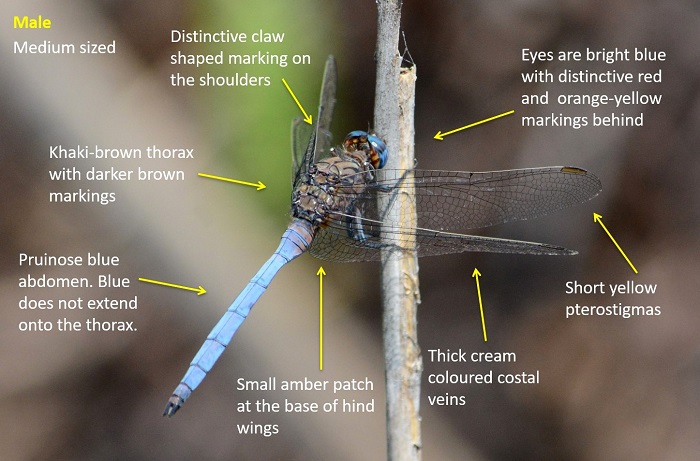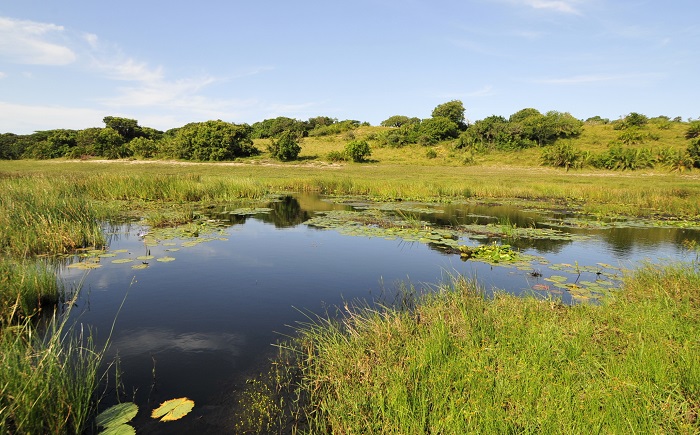The photo above (by John Wilkinson) can be viewed in OdonataMAP here.
Find this species in the FBIS database (Freshwater Biodiversity Information System) here.
Family Libellulidae
Orthetrum monardi – WOODLAND SKIMMER
Identification
Medium sized
Length reaches 45mm.
Males can be confused with several other Orthetrum species. They are most similar to Orthetrum chrysostigma (Epaulet Skimmer) in terms of size and behaviour, but O. monardi lacks the pale diagonal stripes on the thorax of that species. Most comparable to Orthetrum robustum in general colouration, but that species is significantly larger.
The females resemble the males but are generally duller and lack the pruinose blue abdomen.
Click here for more details on identification.

Photo by Ryan Tippett
Habitat
Frequents grassy pans and ponds surrounded by woodland or coastal forest. Also found at clearings in woodland with marshy ground and clumps of tall grass. Frequently found where there are bare, damp patches of mud or sandy substrate at the waters edge.

Photo by Ryan Tippett
Behaviour
Males like to perch low down on grass or reed stems near the waters edge. Woodland Skimmers are often fairly confiding and reluctant to fly. Once disturbed they seldom fly far before resettling.
Status and Conservation
Orthetrum monardi is currently listed as of Least Concern in the IUCN Red List of Threatened Species. The status of this scarce species in South Africa is uncertain. It was first recorded in the country as recently as 2014. This species appears to be fairly sensitive to habitat damage and is mostly found in undisturbed areas.
Distribution
Widespread, but thinly distributed in sub-Saharan Africa. It occurs from Guinea-Bissau and The Gambia in West Africa across to East Africa and down to South Africa. Most records in South Africa come from the coastal region of NE KwaZulu-Natal, extending as far south as Richards Bay. There are also a few records from Limpopo Province and a recent and perhaps, isolated record from Gauteng.
Below is a map showing the distribution of records for Woodland Skimmer in the OdonataMAP database as at February 2020.

The next map below is an imputed map, produced by an interpolation algorithm, which attempts to generate a full distribution map from the partial information in the map above. This map will be improved by the submission of records to the OdonataMAP section of the Virtual Museum.


Ultimately, we will produce a series of maps for all the odonata species in the region. The current algorithm is a new algorithm. The objective is mainly to produce “smoothed” maps that could go into a field guide for odonata. This basic version of the algorithm (as mapped above) does not make use of “explanatory variables” (e.g. altitude, terrain roughness, presence of freshwater — we will be producing maps that take these variables into account soon). Currently, it only makes use of the OdonataMAP records for the species being mapped, as well as all the other records of all other species. The basic maps are “optimistic” and will generally show ranges to be larger than what they probably are.
These maps use the data in the OdonataMAP section of the Virtual Museum, and also the database assembled by the previous JRS funded project, which was led by Professor Michael Samways and Dr KD Dijkstra.

